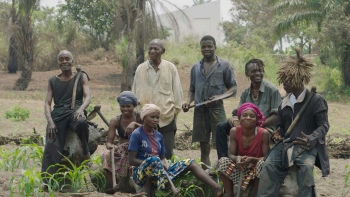CATPC
Works
White Cube Lusanga

Date
2023
Material
Cocoa, palm oil, sugar
Description
The sculptures are made of clay from the remaining old-growth forests around Lusanga, recast in cacao, palm fat, and sugar in Amsterdam. Each marks the passage from a painful and dark past to an ecological tomorrow. CATPC argues that many museums were financed—at least in part—with profits from plantations. CATPC claims these plantations are still being exploited today and that the wealth extracted from them continues to flow to museums through corporate sponsorship. With the profits from their art, CATPC buys back depleted plantation land and restores it as biodiverse food forests for their community.
White Cube Lusanga by Jean Kawata and Ced’art Tamasala depicts the museum of Lusanga, crowned by a Pende carving intertwined with other sacred sculptures that were looted during the colonial era and remain confined in other white cube museums in the Global North.
Plantation Master
CATPC/Olele Mulele Labamba
Date
2023
Material
Cocoa, palm oil, sugar
Description
Plantation Master by Olele Mulele Labamba underscores the community’s role in plantation life. Someone has been caught by the “Plantation Master” because his feet were clean, unsoiled by dirt. But instead of being punished, he is given the tools to work properly.
Fish Protector
CATPC/Daniel Mvunzi
Date
2023
Material
Cocoa, palm oil, sugar
Description
In Fish Protector, the artist Daniel Mvunzi emphasizes that healing the land is central to postplantation life—as is caring for one another. A mysterious fish protects her offspring, swallowing them whole when danger threatens to keep them safe in her belly.
CATPC stands for Cercle d’Arts des Travailleurs de Plantation Congolaise. The artists, themselves, work on plantations.


